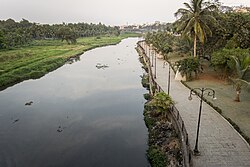| Musi River Muchukunda River | |
|---|---|
 Musi river seen from Nayapul bridge in Hyderabad | |
 | |
| Location | |
| State | Telangana |
| Origin | Ananthagiri Hills, Vikarabad |
| Physical characteristics | |
| Length | 250 km |
| Basin features | |
| Bridges | Purana Pul Naya Pul |
The Musi River, also known as Muchukunda or Musunuru river, [1] is a major tributary of the Krishna River in the Deccan Plateau, flowing through Telangana, India. Hyderabad stands on the banks of the Musi River, and the river divides the historic Old City from the newer part of the city. The Musi flows into Himayat Sagar and Osman Sagar, which are artificial lakes that act as reservoirs that once supplied the twin cities of Hyderabad and Secunderabad with drinking water. The Musi originates in the Ananthagiri Hills, near Vikarabad. It generally flows towards the east, turning south at Chittaloor. It flows into the Krishna River at Vadapally near Miryalaguda in Nalgonda district.

